University Assignment: Nursing Shortage Literature Review Analysis
VerifiedAdded on 2022/08/25
|6
|1452
|28
Report
AI Summary
This report presents a literature review focused on the escalating nursing shortage in Canada and its implications for healthcare quality. The review examines various factors contributing to the shortage, including inadequate staffing levels, nurse burnout, and the aging nursing workforce, as well as the impact of these issues on patient care and outcomes. The review also explores the challenges in both hospital and home-based nursing settings, highlighting the need for intervention strategies. Key findings from the literature emphasize the role of experience, training, and retention strategies in mitigating the shortage, as well as the importance of organizational factors like wages and benefits in attracting and retaining nurses. The report concludes by underscoring the urgent need for further research and intervention to address this critical issue and improve the quality of care provided to patients across the Canadian healthcare system.
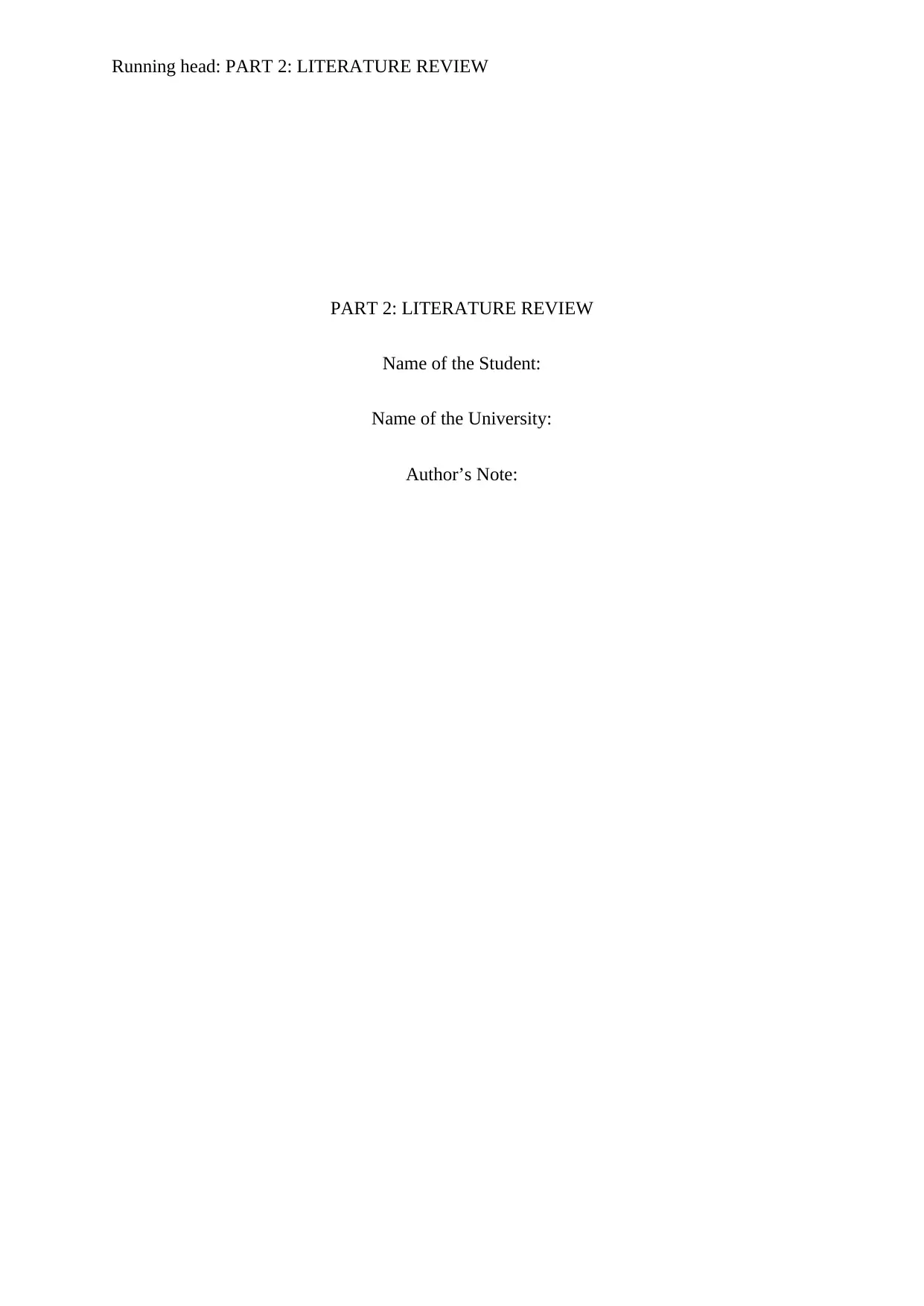
Running head: PART 2: LITERATURE REVIEW
PART 2: LITERATURE REVIEW
Name of the Student:
Name of the University:
Author’s Note:
PART 2: LITERATURE REVIEW
Name of the Student:
Name of the University:
Author’s Note:
Paraphrase This Document
Need a fresh take? Get an instant paraphrase of this document with our AI Paraphraser
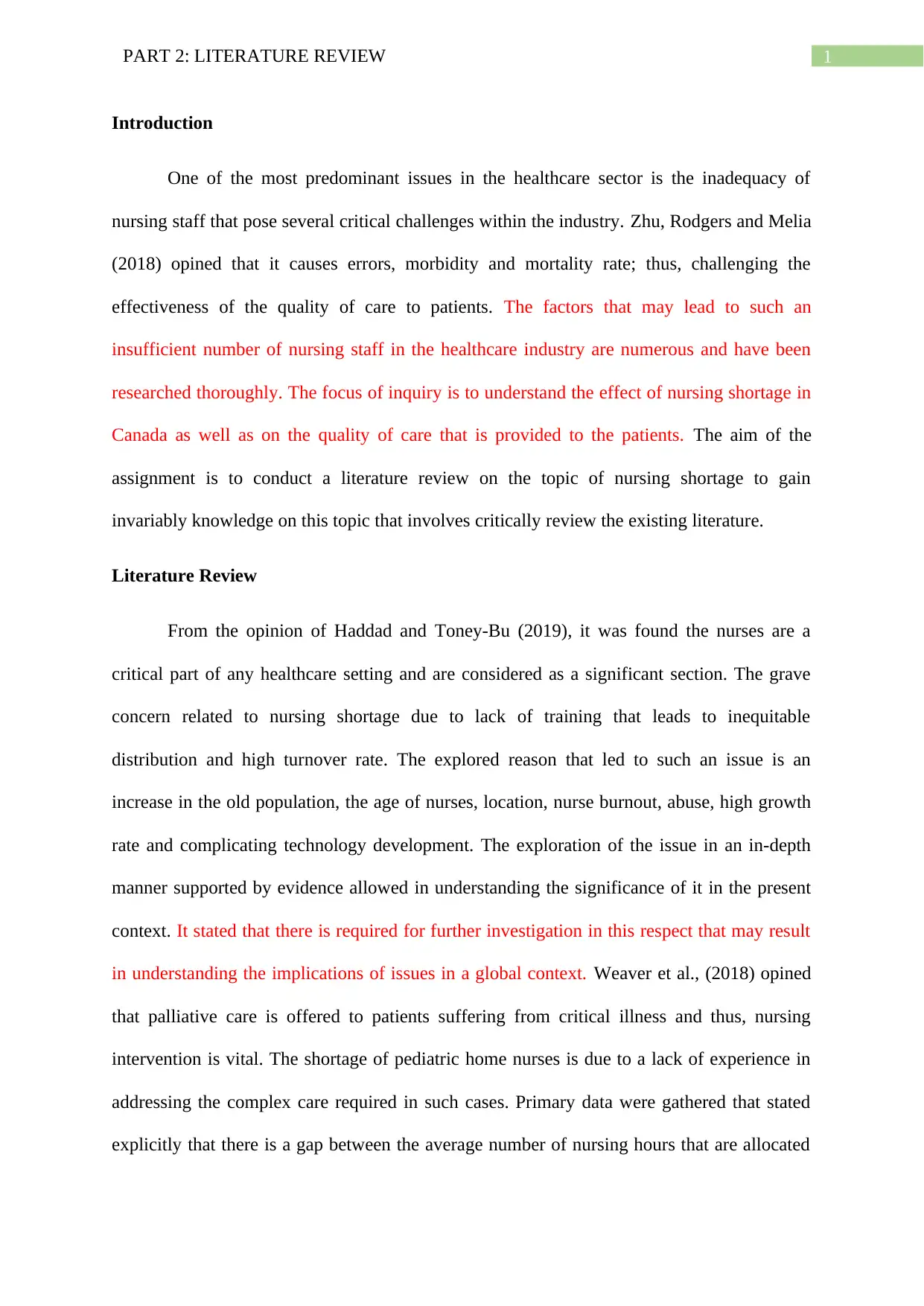
1PART 2: LITERATURE REVIEW
Introduction
One of the most predominant issues in the healthcare sector is the inadequacy of
nursing staff that pose several critical challenges within the industry. Zhu, Rodgers and Melia
(2018) opined that it causes errors, morbidity and mortality rate; thus, challenging the
effectiveness of the quality of care to patients. The factors that may lead to such an
insufficient number of nursing staff in the healthcare industry are numerous and have been
researched thoroughly. The focus of inquiry is to understand the effect of nursing shortage in
Canada as well as on the quality of care that is provided to the patients. The aim of the
assignment is to conduct a literature review on the topic of nursing shortage to gain
invariably knowledge on this topic that involves critically review the existing literature.
Literature Review
From the opinion of Haddad and Toney-Bu (2019), it was found the nurses are a
critical part of any healthcare setting and are considered as a significant section. The grave
concern related to nursing shortage due to lack of training that leads to inequitable
distribution and high turnover rate. The explored reason that led to such an issue is an
increase in the old population, the age of nurses, location, nurse burnout, abuse, high growth
rate and complicating technology development. The exploration of the issue in an in-depth
manner supported by evidence allowed in understanding the significance of it in the present
context. It stated that there is required for further investigation in this respect that may result
in understanding the implications of issues in a global context. Weaver et al., (2018) opined
that palliative care is offered to patients suffering from critical illness and thus, nursing
intervention is vital. The shortage of pediatric home nurses is due to a lack of experience in
addressing the complex care required in such cases. Primary data were gathered that stated
explicitly that there is a gap between the average number of nursing hours that are allocated
Introduction
One of the most predominant issues in the healthcare sector is the inadequacy of
nursing staff that pose several critical challenges within the industry. Zhu, Rodgers and Melia
(2018) opined that it causes errors, morbidity and mortality rate; thus, challenging the
effectiveness of the quality of care to patients. The factors that may lead to such an
insufficient number of nursing staff in the healthcare industry are numerous and have been
researched thoroughly. The focus of inquiry is to understand the effect of nursing shortage in
Canada as well as on the quality of care that is provided to the patients. The aim of the
assignment is to conduct a literature review on the topic of nursing shortage to gain
invariably knowledge on this topic that involves critically review the existing literature.
Literature Review
From the opinion of Haddad and Toney-Bu (2019), it was found the nurses are a
critical part of any healthcare setting and are considered as a significant section. The grave
concern related to nursing shortage due to lack of training that leads to inequitable
distribution and high turnover rate. The explored reason that led to such an issue is an
increase in the old population, the age of nurses, location, nurse burnout, abuse, high growth
rate and complicating technology development. The exploration of the issue in an in-depth
manner supported by evidence allowed in understanding the significance of it in the present
context. It stated that there is required for further investigation in this respect that may result
in understanding the implications of issues in a global context. Weaver et al., (2018) opined
that palliative care is offered to patients suffering from critical illness and thus, nursing
intervention is vital. The shortage of pediatric home nurses is due to a lack of experience in
addressing the complex care required in such cases. Primary data were gathered that stated
explicitly that there is a gap between the average number of nursing hours that are allocated
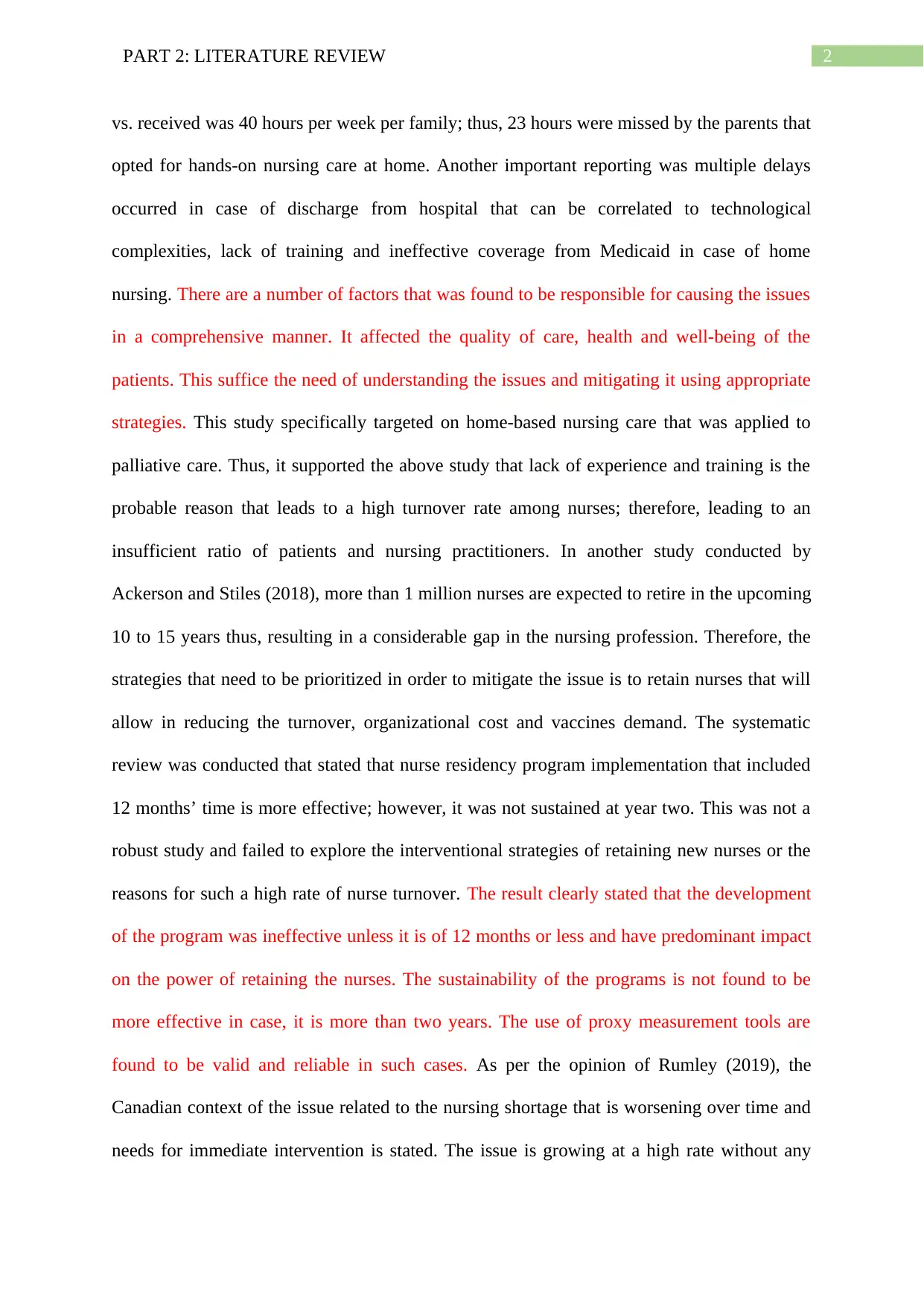
2PART 2: LITERATURE REVIEW
vs. received was 40 hours per week per family; thus, 23 hours were missed by the parents that
opted for hands-on nursing care at home. Another important reporting was multiple delays
occurred in case of discharge from hospital that can be correlated to technological
complexities, lack of training and ineffective coverage from Medicaid in case of home
nursing. There are a number of factors that was found to be responsible for causing the issues
in a comprehensive manner. It affected the quality of care, health and well-being of the
patients. This suffice the need of understanding the issues and mitigating it using appropriate
strategies. This study specifically targeted on home-based nursing care that was applied to
palliative care. Thus, it supported the above study that lack of experience and training is the
probable reason that leads to a high turnover rate among nurses; therefore, leading to an
insufficient ratio of patients and nursing practitioners. In another study conducted by
Ackerson and Stiles (2018), more than 1 million nurses are expected to retire in the upcoming
10 to 15 years thus, resulting in a considerable gap in the nursing profession. Therefore, the
strategies that need to be prioritized in order to mitigate the issue is to retain nurses that will
allow in reducing the turnover, organizational cost and vaccines demand. The systematic
review was conducted that stated that nurse residency program implementation that included
12 months’ time is more effective; however, it was not sustained at year two. This was not a
robust study and failed to explore the interventional strategies of retaining new nurses or the
reasons for such a high rate of nurse turnover. The result clearly stated that the development
of the program was ineffective unless it is of 12 months or less and have predominant impact
on the power of retaining the nurses. The sustainability of the programs is not found to be
more effective in case, it is more than two years. The use of proxy measurement tools are
found to be valid and reliable in such cases. As per the opinion of Rumley (2019), the
Canadian context of the issue related to the nursing shortage that is worsening over time and
needs for immediate intervention is stated. The issue is growing at a high rate without any
vs. received was 40 hours per week per family; thus, 23 hours were missed by the parents that
opted for hands-on nursing care at home. Another important reporting was multiple delays
occurred in case of discharge from hospital that can be correlated to technological
complexities, lack of training and ineffective coverage from Medicaid in case of home
nursing. There are a number of factors that was found to be responsible for causing the issues
in a comprehensive manner. It affected the quality of care, health and well-being of the
patients. This suffice the need of understanding the issues and mitigating it using appropriate
strategies. This study specifically targeted on home-based nursing care that was applied to
palliative care. Thus, it supported the above study that lack of experience and training is the
probable reason that leads to a high turnover rate among nurses; therefore, leading to an
insufficient ratio of patients and nursing practitioners. In another study conducted by
Ackerson and Stiles (2018), more than 1 million nurses are expected to retire in the upcoming
10 to 15 years thus, resulting in a considerable gap in the nursing profession. Therefore, the
strategies that need to be prioritized in order to mitigate the issue is to retain nurses that will
allow in reducing the turnover, organizational cost and vaccines demand. The systematic
review was conducted that stated that nurse residency program implementation that included
12 months’ time is more effective; however, it was not sustained at year two. This was not a
robust study and failed to explore the interventional strategies of retaining new nurses or the
reasons for such a high rate of nurse turnover. The result clearly stated that the development
of the program was ineffective unless it is of 12 months or less and have predominant impact
on the power of retaining the nurses. The sustainability of the programs is not found to be
more effective in case, it is more than two years. The use of proxy measurement tools are
found to be valid and reliable in such cases. As per the opinion of Rumley (2019), the
Canadian context of the issue related to the nursing shortage that is worsening over time and
needs for immediate intervention is stated. The issue is growing at a high rate without any
⊘ This is a preview!⊘
Do you want full access?
Subscribe today to unlock all pages.

Trusted by 1+ million students worldwide
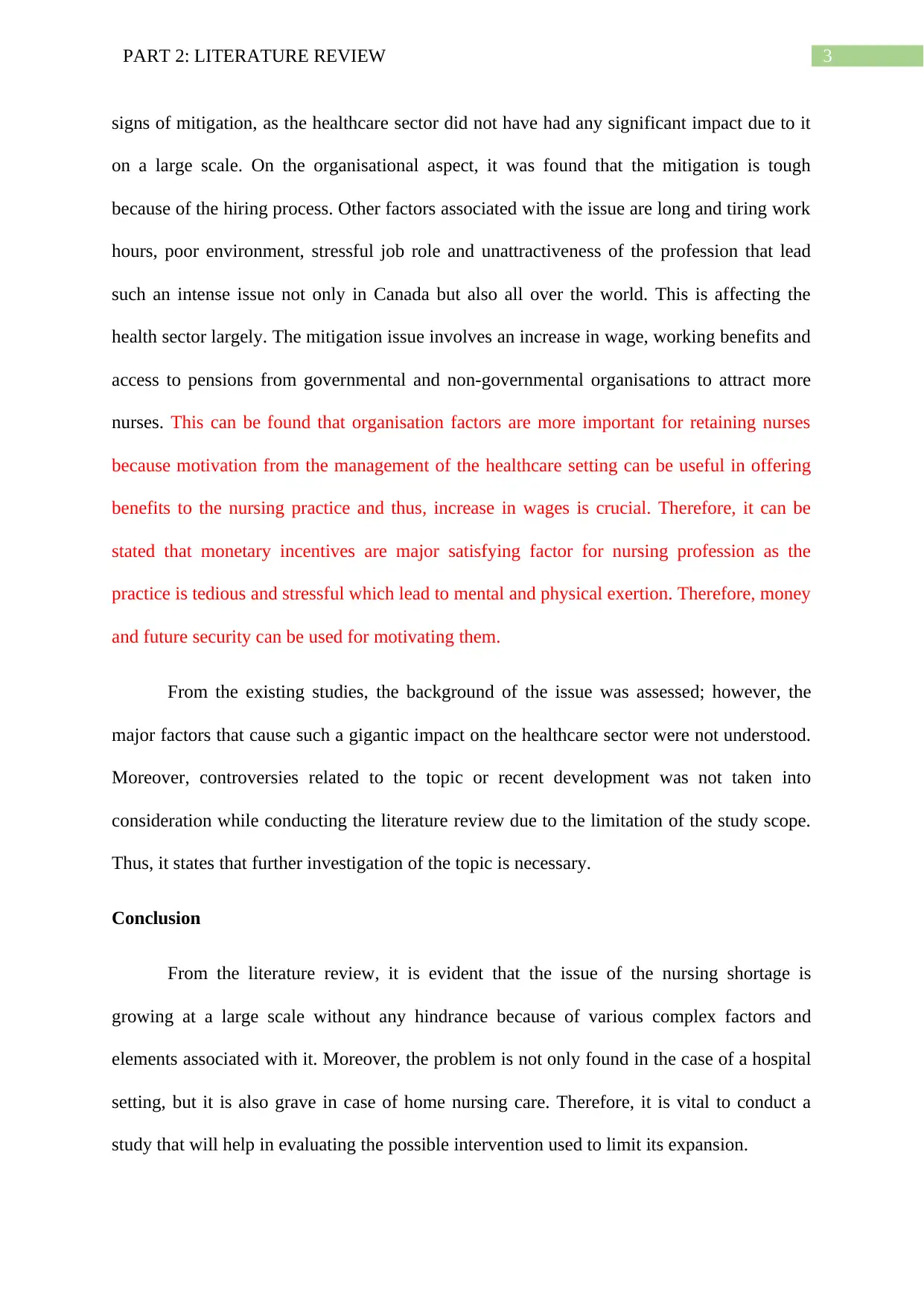
3PART 2: LITERATURE REVIEW
signs of mitigation, as the healthcare sector did not have had any significant impact due to it
on a large scale. On the organisational aspect, it was found that the mitigation is tough
because of the hiring process. Other factors associated with the issue are long and tiring work
hours, poor environment, stressful job role and unattractiveness of the profession that lead
such an intense issue not only in Canada but also all over the world. This is affecting the
health sector largely. The mitigation issue involves an increase in wage, working benefits and
access to pensions from governmental and non-governmental organisations to attract more
nurses. This can be found that organisation factors are more important for retaining nurses
because motivation from the management of the healthcare setting can be useful in offering
benefits to the nursing practice and thus, increase in wages is crucial. Therefore, it can be
stated that monetary incentives are major satisfying factor for nursing profession as the
practice is tedious and stressful which lead to mental and physical exertion. Therefore, money
and future security can be used for motivating them.
From the existing studies, the background of the issue was assessed; however, the
major factors that cause such a gigantic impact on the healthcare sector were not understood.
Moreover, controversies related to the topic or recent development was not taken into
consideration while conducting the literature review due to the limitation of the study scope.
Thus, it states that further investigation of the topic is necessary.
Conclusion
From the literature review, it is evident that the issue of the nursing shortage is
growing at a large scale without any hindrance because of various complex factors and
elements associated with it. Moreover, the problem is not only found in the case of a hospital
setting, but it is also grave in case of home nursing care. Therefore, it is vital to conduct a
study that will help in evaluating the possible intervention used to limit its expansion.
signs of mitigation, as the healthcare sector did not have had any significant impact due to it
on a large scale. On the organisational aspect, it was found that the mitigation is tough
because of the hiring process. Other factors associated with the issue are long and tiring work
hours, poor environment, stressful job role and unattractiveness of the profession that lead
such an intense issue not only in Canada but also all over the world. This is affecting the
health sector largely. The mitigation issue involves an increase in wage, working benefits and
access to pensions from governmental and non-governmental organisations to attract more
nurses. This can be found that organisation factors are more important for retaining nurses
because motivation from the management of the healthcare setting can be useful in offering
benefits to the nursing practice and thus, increase in wages is crucial. Therefore, it can be
stated that monetary incentives are major satisfying factor for nursing profession as the
practice is tedious and stressful which lead to mental and physical exertion. Therefore, money
and future security can be used for motivating them.
From the existing studies, the background of the issue was assessed; however, the
major factors that cause such a gigantic impact on the healthcare sector were not understood.
Moreover, controversies related to the topic or recent development was not taken into
consideration while conducting the literature review due to the limitation of the study scope.
Thus, it states that further investigation of the topic is necessary.
Conclusion
From the literature review, it is evident that the issue of the nursing shortage is
growing at a large scale without any hindrance because of various complex factors and
elements associated with it. Moreover, the problem is not only found in the case of a hospital
setting, but it is also grave in case of home nursing care. Therefore, it is vital to conduct a
study that will help in evaluating the possible intervention used to limit its expansion.
Paraphrase This Document
Need a fresh take? Get an instant paraphrase of this document with our AI Paraphraser
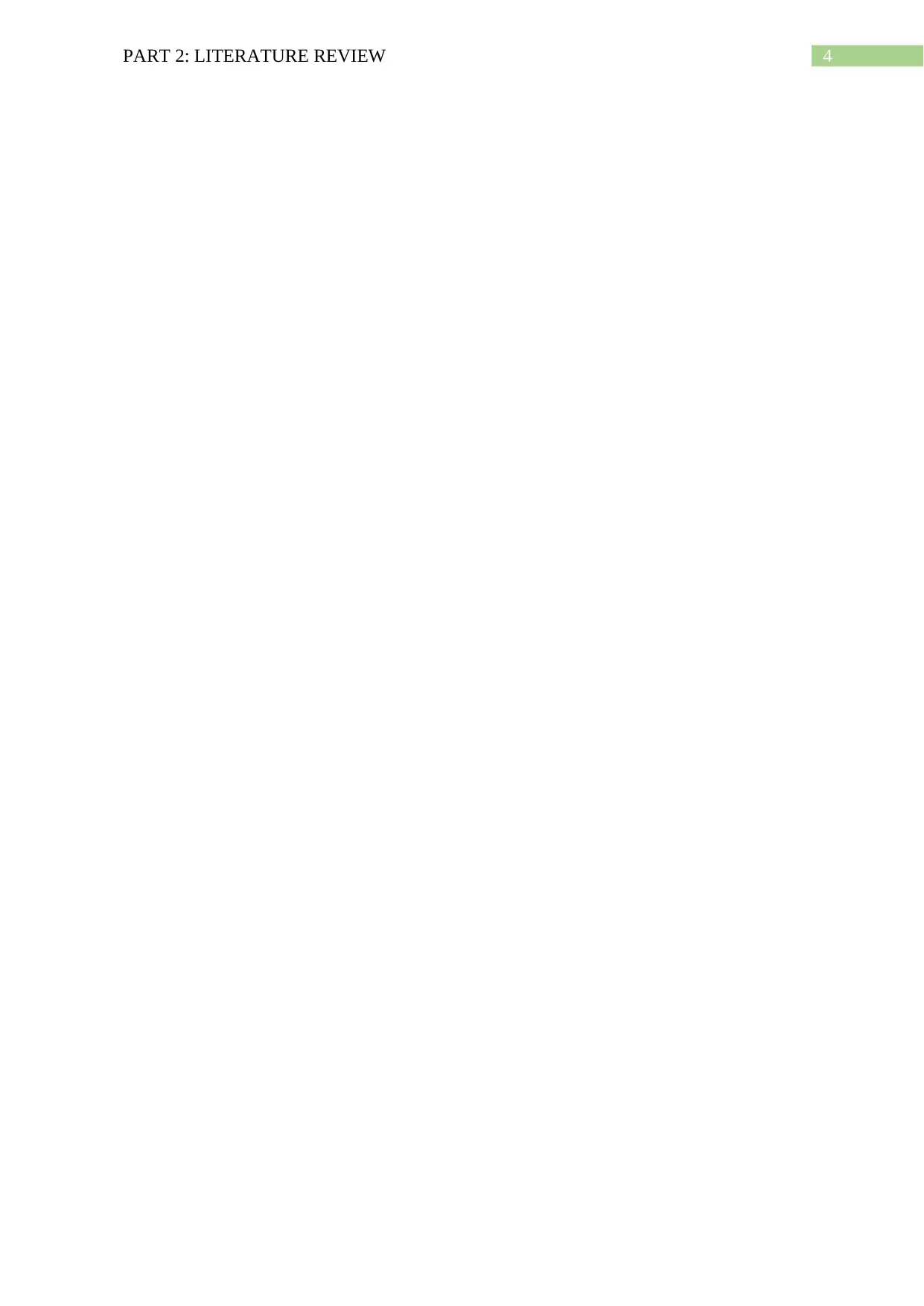
4PART 2: LITERATURE REVIEW
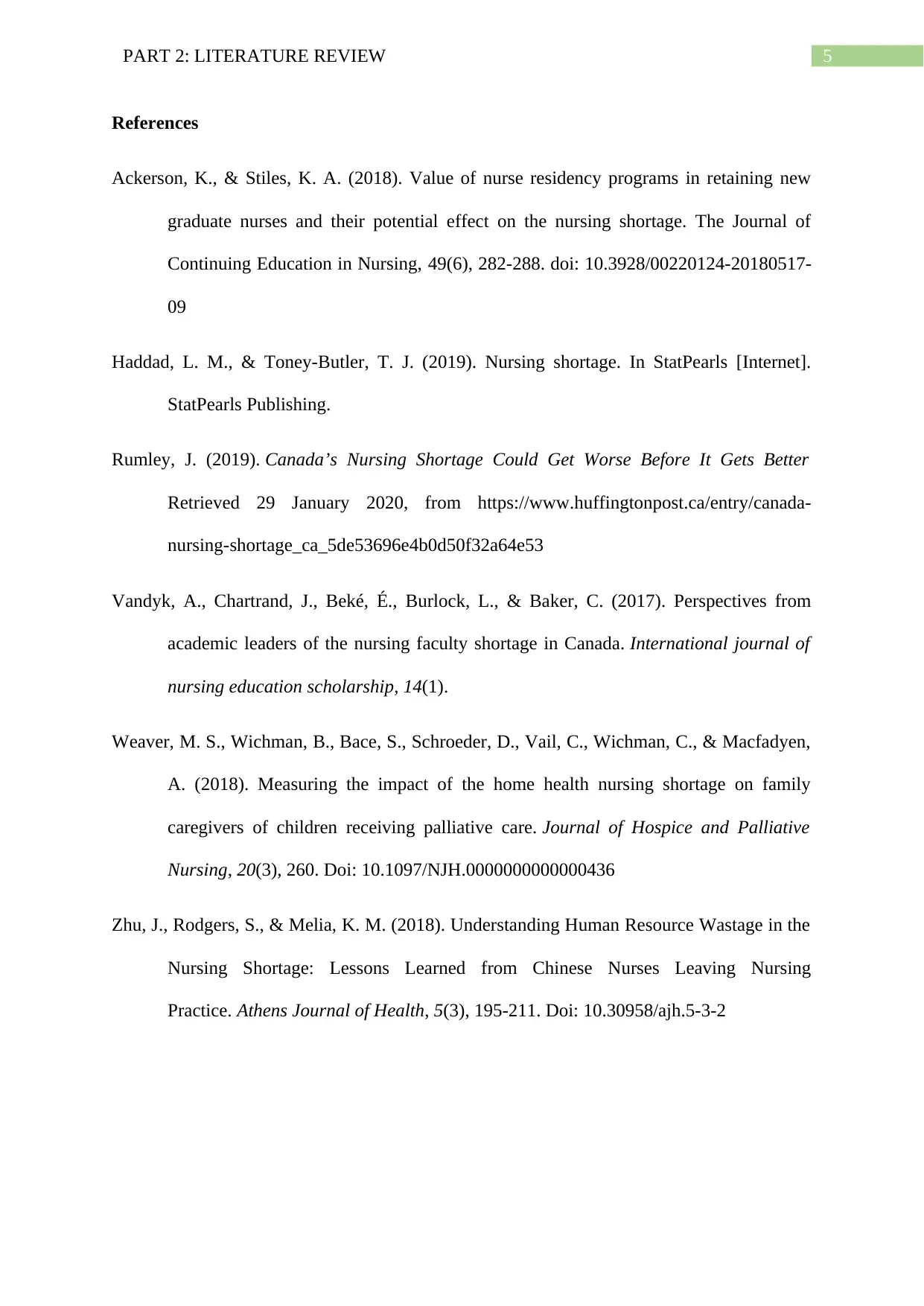
5PART 2: LITERATURE REVIEW
References
Ackerson, K., & Stiles, K. A. (2018). Value of nurse residency programs in retaining new
graduate nurses and their potential effect on the nursing shortage. The Journal of
Continuing Education in Nursing, 49(6), 282-288. doi: 10.3928/00220124-20180517-
09
Haddad, L. M., & Toney-Butler, T. J. (2019). Nursing shortage. In StatPearls [Internet].
StatPearls Publishing.
Rumley, J. (2019). Canada’s Nursing Shortage Could Get Worse Before It Gets Better
Retrieved 29 January 2020, from https://www.huffingtonpost.ca/entry/canada-
nursing-shortage_ca_5de53696e4b0d50f32a64e53
Vandyk, A., Chartrand, J., Beké, É., Burlock, L., & Baker, C. (2017). Perspectives from
academic leaders of the nursing faculty shortage in Canada. International journal of
nursing education scholarship, 14(1).
Weaver, M. S., Wichman, B., Bace, S., Schroeder, D., Vail, C., Wichman, C., & Macfadyen,
A. (2018). Measuring the impact of the home health nursing shortage on family
caregivers of children receiving palliative care. Journal of Hospice and Palliative
Nursing, 20(3), 260. Doi: 10.1097/NJH.0000000000000436
Zhu, J., Rodgers, S., & Melia, K. M. (2018). Understanding Human Resource Wastage in the
Nursing Shortage: Lessons Learned from Chinese Nurses Leaving Nursing
Practice. Athens Journal of Health, 5(3), 195-211. Doi: 10.30958/ajh.5-3-2
References
Ackerson, K., & Stiles, K. A. (2018). Value of nurse residency programs in retaining new
graduate nurses and their potential effect on the nursing shortage. The Journal of
Continuing Education in Nursing, 49(6), 282-288. doi: 10.3928/00220124-20180517-
09
Haddad, L. M., & Toney-Butler, T. J. (2019). Nursing shortage. In StatPearls [Internet].
StatPearls Publishing.
Rumley, J. (2019). Canada’s Nursing Shortage Could Get Worse Before It Gets Better
Retrieved 29 January 2020, from https://www.huffingtonpost.ca/entry/canada-
nursing-shortage_ca_5de53696e4b0d50f32a64e53
Vandyk, A., Chartrand, J., Beké, É., Burlock, L., & Baker, C. (2017). Perspectives from
academic leaders of the nursing faculty shortage in Canada. International journal of
nursing education scholarship, 14(1).
Weaver, M. S., Wichman, B., Bace, S., Schroeder, D., Vail, C., Wichman, C., & Macfadyen,
A. (2018). Measuring the impact of the home health nursing shortage on family
caregivers of children receiving palliative care. Journal of Hospice and Palliative
Nursing, 20(3), 260. Doi: 10.1097/NJH.0000000000000436
Zhu, J., Rodgers, S., & Melia, K. M. (2018). Understanding Human Resource Wastage in the
Nursing Shortage: Lessons Learned from Chinese Nurses Leaving Nursing
Practice. Athens Journal of Health, 5(3), 195-211. Doi: 10.30958/ajh.5-3-2
⊘ This is a preview!⊘
Do you want full access?
Subscribe today to unlock all pages.

Trusted by 1+ million students worldwide
1 out of 6
Related Documents
Your All-in-One AI-Powered Toolkit for Academic Success.
+13062052269
info@desklib.com
Available 24*7 on WhatsApp / Email
![[object Object]](/_next/static/media/star-bottom.7253800d.svg)
Unlock your academic potential
Copyright © 2020–2025 A2Z Services. All Rights Reserved. Developed and managed by ZUCOL.





